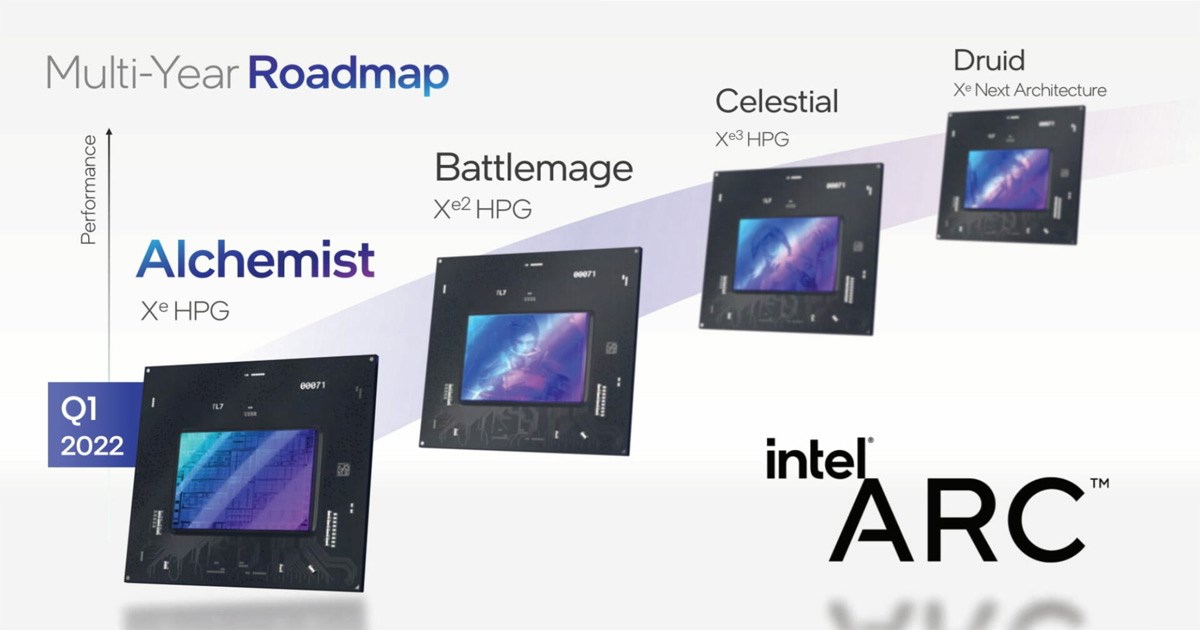 Release: Q1 of 2022
Release: Q1 of 2022
 Codename: ARC Alchemist, previously known as DG2
Codename: ARC Alchemist, previously known as DG2
 Architecture: Xe-HPG, build for gaming first and successor to Xe-LP and Xe-HPC architectures
Architecture: Xe-HPG, build for gaming first and successor to Xe-LP and Xe-HPC architectures
 Process: TSMC 6nm (N6)
Process: TSMC 6nm (N6)
 Performance target: Unknown; Nvidia GeForce RTX 3070 (rumour)
Performance target: Unknown; Nvidia GeForce RTX 3070 (rumour)
 DisplayPort 2.0: Yes
DisplayPort 2.0: Yes
Whether or not Intel will manage to come right out of the gates with a monster GPU remains to be seen, but if Radeon’s Vega hype and launch back in 2017 is anything to go by, many gamers are cautiously excited and managing their expectations.
As of yet, we do not have exact specification for ARC Alchemist, however Intel has provided some details to the capabilities of the new GPU. So far, we know that the Alchemist is being developed on TSMC 6nm FinFET (N6) and uses Xe-HPG architecture.
For those who are not familiar, TSMC already manufactures graphics cards for gaming. It makes all of AMD’s RX 6000-series GPUs on its 7nm as well as all of Ryzen 5000 CPUs. TSMC used to make Nvidia’s GPUs, however Nvidia GPU manufacture is now with Samsung.
Intel’s Arc (not to be confused with Intel Ark – the product specification site), isn’t going to be built on TSMC’s latest, most cutting-edge process, 5nm. Instead, it will be built on mn6. This isn’t necessarily a concern, especially since we expect mn6 to be a lot more solid and proven process node by the time we get Intel’s ARC Alchemist GPU.
During the Architecture Day 2021, Intel gave us a preview of their AI-accelerated super sampling, now known as XeSS. Similar to Nvidia’s DLSS, XeSS will upscale lower res games with minimal compromise in image resolution in order to provide smoother frame rates.
Intel has shown a controlled demo of their XeSS rendering at a fairly steady pace, so it isn’t clear how well XeSS will perform in a high paced gaming environment, especially compared to other AI-based upscaling technologies, such as Nvidia’s DLSS.
The demo was genuinely impressive. At first, it appears to show that XeSS is rendering real-time in 4K, however the engine actually renders to a much smaller 1080p and is then upscaled to 4K by the XeSS without any visible quality loss. This gives the same quality picture as the native 4K capable consoles and PCs. Due to the rendering target being so low, the rendering time will be reduced, thus allowing better FPS rates. This would also allow for low resolution games to be played in 4K.
ARC Alchemist will be the first gen of Intel’s GPUs and will debut their entry into the market that’s currently dominated by Nvidia and AMD. Intel further reveled that they aren’t just dipping their toes into the GPU market, but are coming full speed.
Their Multi-Year GPU Roadmap confirmed that Intel has every intention to be a real competition to Nvidia and AMD. Alchemist is coming in the first quarter of 2022, with Battlemage, Celestial and Druid CPUs to look forward to in the upcoming years.

Alchemist, Battlemage, Celestial and Druid are excellent names for GPUs aimed at gamers, as they are either alluding to certain games, classes or actual characters in gaming.
Each gamer may interpret the names differently, but our associations are as follows:
Battlemage – Class in Elder Scrolls; Celestial – creatures from Dungeons and Dragons; Druid – Class in World of Warcraft. There’s no clear consensus on the Alchemist, so we went with Dungeons and Dragons.
Everything about Intel’s upcoming GPUs is aimed at gamers, and we’re hoping the specs and the performance will match the branding enthusiasm.
Intel ARC Alchemist still has some months to go before the release, but it is rumored that its performance can currently match GeForce RTX 3060. That may not sound too impressive now, but we’re still to see how far Intel can take ARC Alchemist, and whether the performance at launch will surpass current expectations.
Should AMD and NVIDIA be concerned?
It is far too early to tell how Intel will do with gamers until we get to put the GPUs to the gaming test. The demos all look very impressive, as do the expected specs, so all else being equal should AMD and NVIDIA be concerned or is Intel late to the party?
It all depends on how Intel preforms side by side with AMD and NVIDIA. Intel is not new to gaming, or even manufacturing GPUs and from what they’ve shown us in the demo and from what we’ve seen, Alchemist could be a game-changer.
However, neither AMD nor NVIDIA are at a standstill. Both companies make the industry standard GPUs, and both have fans dedicated to the product. This is especially true for gamers. For the vast majority of gamers, NVIDIA or AMD is a matter of personal preference and what works best for them. It remains to be seen where Intel’s ARC Alchemist will land on the market and with gamers.
The general lack of GPU availability right now makes us even more excited for Intel ARC Alchemist though we’ve not been given an indication as to the pricing. Since Intel isn’t new to updating and writing GPUs, and just like AMD and NVIDIA, Intel is known for releasing stable drivers and beta drivers for specific games. We expect the price to be in the range with AMD and NVIDIA.







